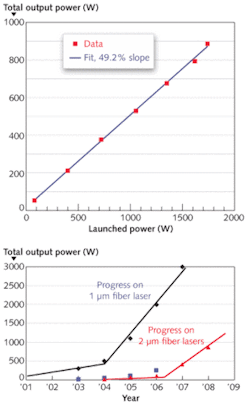
Adrian Carter, Bryce Samson, and Kanishka Tankala
Fiber lasers have matured from a niche-market technology into a mainstream laser platform with annual sales surpassing $100 million in 2006. Until recently, the only high-power fiber-laser technology was based on ytterbium (Yb)-doped fibers lasing at around 1 µm, a technology developed in the previous decade. In the meantime, despite numerous claims of breakthrough fiber technologies, very few have progressed as rapidly as the 2 µm fiber laser, a new class of high-power laser based on highly efficient lasing of thulium (Tm)-doped silica fibers.
This latest member of the kilowatt-class laser family has the advantage of operating at an “eye-safe” wavelength and uses commercially available, high-power diode technology at 790 nm. Based on telecom-grade silica fiber technology, these Tm-doped fibers are compatible with much of the infrastructure and components already developed for use at 1 µm, which together with the current availability of pump diodes will facilitate the rapid adoption of the technology.
Historical
The cross-relaxation of Tm ions in solid-state crystal lasers, wherein one Tm ion absorbs the 790 nm pump photon and subsequently produces two excited ions in the metastable lasing level has been well known for many years. Optimization of this process can facilitate generation of two lasing photons for each pump photon, thereby enabling a theoretical quantum efficiency approaching 200%. The recent extension to and exploitation of this phenomenon in silica fibers has resulted in steady slope efficiency improvement of 790 nm pumped Tm fibers from around 30% in 1998 to almost 70% in 2005 (see Fig. 1).1
As efficiency has improved, the achievable output power from a single Tm-doped fiber has begun to approach the kilowatt level (see Fig. 2).2 Although the highest output powers reported to date were not achieved with perfect, near-diffraction-limited beam quality (due to the multimode nature of the fibers used), they were nevertheless limited only by available pump power and therefore demonstrate the potential for the technology to produce kilowatt power levels.In fact, an extension of the same highly efficient fiber technology combined with a large-mode-area (LMA) design, in which the effective core numerical aperture is reduced through the incorporation of a carefully designed pedestal layer, has recently been demonstrated, and polarization-maintaining (PM) versions of this fiber design have also been produced.3 An important factor contributing to these power-scaling results is the availability of high-brightness, high-power pump diodes at 790 nm, which are essentially a variation of the 808 nm versions commercially available for Nd:YAG pumping. We believe the widespread availability of suitable high-power pump diodes is an important factor in the cost of developing and adopting this new fiber-laser technology.
State of the art
Additional factors have also led to an interest in Tm-doped fibers at 2 µm. Compared to Yb-doped fibers, the spectral tunability of Tm-doped fibers is significantly broader, spanning wavelengths from below 1850 nm to beyond 2100 nm, corresponding to more than 200 nm of available bandwidth.4 This wavelength region covers the water absorption peaks around 1940 nm, making these lasers a valuable tool for various medical procedures including noninvasive surgery,5 as well as several atmospheric transmission windows that are useful for remote sensing, laser radar, range-finding, and high-energy laser weapons. Indeed, by operating within the so-called eye-safe wavelength region the permissible exposure levels can be several orders of magnitude higher than at 1 µm, a feature of Tm-doped lasers that has caught the attention of various U.S. Department of Defense groups.
The available bandwidth is also potentially advantageous to research groups interested in ultrafast-pulse generation.6 Furthermore, Tm-fiber lasers operating in pulsed or continuous-wave mode are an attractive high-efficiency pump source for generating mid-IR wavelengths in the 3 to 5 µm range, such as those required in countermeasures applications.7 By frequency-doubling the output of such Tm-doped fibers operating at wavelengths below 1.9 µm, a range of near-IR wavelengths between 900 and 950 nm are opened up that are otherwise difficult to obtain from traditional solid-state sources.8 Subsequent frequency conversion to the blue and UV would add several other important wavelengths that would benefit from the availability of a compact, efficient fiber-based source.Another area of active research is a comparison of limitations imposed by optical nonlinearities in high-power and narrow-linewidth Tm-doped fibers operating at 2 µm with those of Yb-doped fibers at 1 µm. Despite recent advances in LMA fiber technology, the performance of many Yb-doped fiber devices is now limited by nonlinearities, a factor that has led to the investigation of “new” fiber technologies aimed at increasing the size of the optical mode without sacrificing beam quality. Other research has focused on waveguide designs to suppress specific nonlinearities, such as stimulated Brillouin scattering (SBS), through optimization of glass composition and waveguide design.
In this regard, a Tm-doped fiber amplifier was recently shown to have a unique advantage, producing in excess of 600 W of single-mode, less than 5 MHz linewidth output power at 2040 nm (see Fig. 3).9 This is believed to represent the highest power single-frequency, single-mode fiber laser at any wavelength, exceeding all previously reported values at 1 µm and 1.5 µm despite several years of research at these wavelengths. Furthermore, the output power in this amplifier chain was found to be limited only by available pump power rather than SBS and clearly demonstrates the potential for further power scaling narrow linewidths at this eye-safe wavelength.
Outlook
As the technology for 2 µm fiber lasers matures, more components are becoming available, including fiber-coupled isolators, couplers, and fiber Bragg gratings that together enable monolithic lasers/amplifiers to be developed for this wavelength.10 Indeed the similarity with fiber-laser architectures at 1 µm often means that the most-significant investment required is for the diagnostic tools needed to measure at 2 µm, such as optical-spectrum analyzers and suitable 2 µm fiber-coupled seed sources.
Improvements in high-power, high-brightness pump diodes operating around 790 nm, which have become available in the last few years, will further enable 2 µm fiber lasers to operate at higher power levels and allow 2 µm fiber lasers to approach the price targets set by current 1 µm fiber lasers/amplifiers.
REFERENCES
- G. Frith et al, Electronics Lett. 41, p. 1207, (2005).
- P.F. Moulton et al, IEEE J. Sel. Topics in Quantum. Elect. 15(1) p 85.
- G. Frith et al, Proc. SSDLTR 2008, p. 200.
- W.A. Clarkson et al., Optics Lett. 27(22) p. 1989, (2002).
- S. Wenk et al., Springer Series in Physics 114, Advances in Medical Eng., p 227 (2007).
- Haxen et al., Optics Express 16(25) p 20471 (2008).
- D. Creedon et al., Optics Lett. 33, p. 315 (2008).
- G. Frith et al., Proc. ASSP 2009, paper WB5.
- G. Goodno et al., Proc. ASSP 2009, postdeadline paper PD MF2.
- T. Ehrenreich et al., Proc. ASSP 2009, paper WB2.
ACKNOWLEDGMENT
The authors would like to thank Northrop Grumman Space Technology and Q-Peak for several of the figures used in this article.
Adrian Carter is chief technology officer, Bryce Samson is vice president of business development, and Kanishka Tankala is vice president of operations at Nufern, 7 Airport Park Road, East Granby, CT 06026; e-mail: [email protected]; www.nufern.com.

